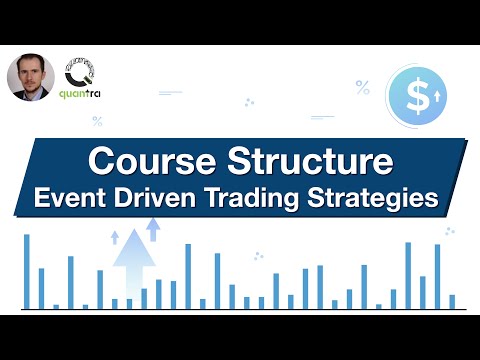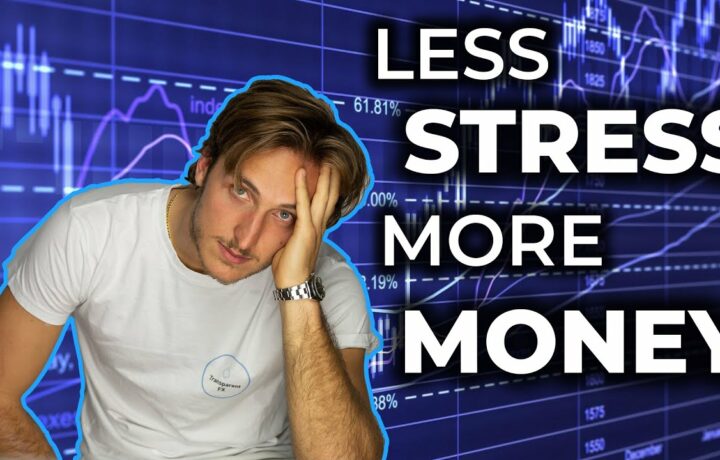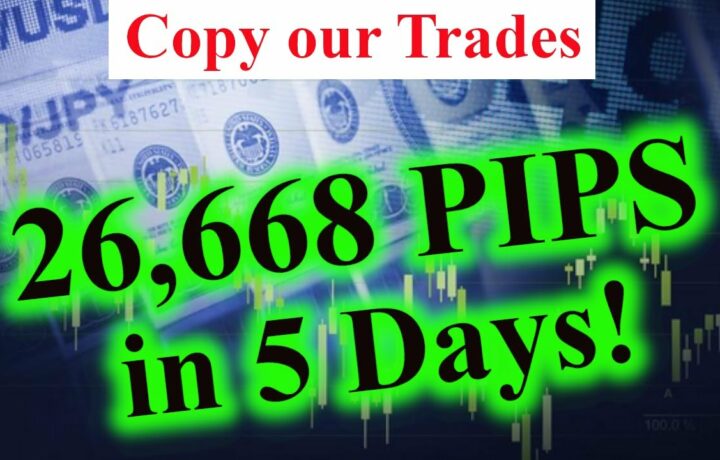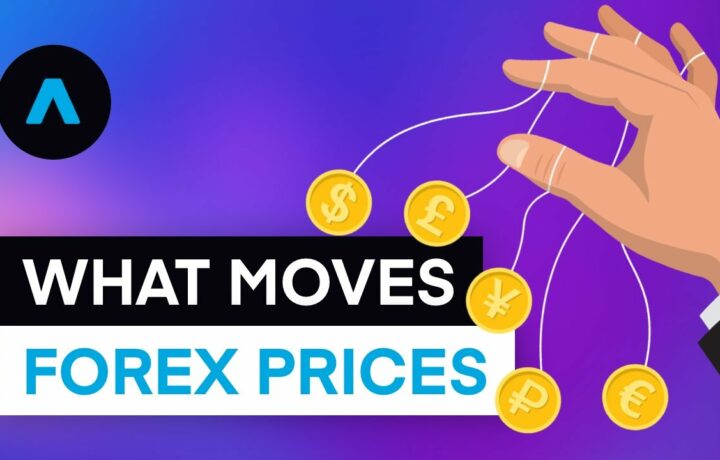Search Popular Articles Relevant to Event Driven Trading Strategies, Event Driven Trading Strategies | Course Structure | Radovan Vojtko | Quantra Courses.
This video is the preview of our brand-new course on Event Driven Trading Strategies which is available right now at a FLAT 60% just-launched discount: https://quantra.quantinsti.com/course/event-driven-trading-strategies
The objective of this course is to equip you with the knowledge of various types of calendar or event-driven trading strategies. After completing this course, you will be able to explain fundamental reasons behind various calendar anomalies strategies.
Create and backtest eight-calendar anomalies strategies in equity, fixed and volatility markets. Enhance existing strategies to improve their performance.
Combine calendar anomaly strategies and create a composite strategy.
You will start this course with some of the well-known examples of seasonal and calendar trading strategies such as the January effect and Halloween effect. Then we move to the advantages and fundamental reasons behind that.
In the following section, you will explore some of the calendar anomalies present in equity markets.
You will start with the turn of the month effect, payday effect, federal effect, and options expirations week effect.
Next, you will learn seasonal anomalies in fixed income markets. The two seasonal anomalies that will explore are auction trading effect and end of the month effect.
In the next section, you will identify seasonal anomalies in the volatility markets. The strategies that you will learn are VIX futures expiration effects and The December effect.
Finally, you will learn to combine these strategies and develop a couple of composite strategies which improve the performance of the strategy and allocate capitals to various sub-strategies. You will also see the impact of trading cost on composite strategy.
At the end, we will analyse the impact of covid-19 pandemic on the overall market and our composite strategy. You will learn these anomalies through examples, fundamental reasons, and performance statistics.
Also, you will gain knowledge to enhance the trading signals of these strategies.
The trading strategies created in the course can be extended further and used for paper and live trading.
You will learn to automate these trading strategies on interactive brokers. At the end of the course, you can access the Jupyter notebooks created in different sections along with the data files from a single downloadable folder.
Let’s get started!
Quantra is an online education portal that specializes in Algorithmic and Quantitative trading. Quantra offers various bite-sized, self-paced and interactive courses that are perfect for busy professionals, seeking implementable knowledge in this domain.
Find more info on – https://quantra.quantinsti.com/
Like us on Facebook: https://www.facebook.com/goquantra/
Follow us on Twitter: https://twitter.com/GoQuantra

Event Driven Trading Strategies, Event Driven Trading Strategies | Course Structure | Radovan Vojtko | Quantra Courses.
The supposed death of event-driven investing
When Event Forex Trading Dead?
When Daniel Loeb, the activist financier, addressed the annual conference of capitalists in Third Factor, his hedge fund, last month, he opened up with an entertaining slide. It showed a bloodied and also damaged animation variation of himself surprising in the direction of a tombstone inscribed with the message “SPLIT event-driven investing, 2015”.
Lest anybody assume 3rd Factor is predicting the demise of one of the most financially rewarding hedge fund approaches of the past few years, the slide was labelled “The supposed death of event-driven investing”. But even Mr Loeb admitted the industry goes to an inflection factor.
Markets changed in the past year
Funds in the event-driven group are a heterogeneous lot, however somehow they aim to benefit from business actions such as financial restructurings or mergings and also purchases. As markets changed in the past year, many funds found themselves banking on the incorrect kinds of business actions. Event-driven approaches that worked in an equity bull market are refraining from doing so now.
This is especially the instance for the brand of activism with which Mr Loeb and also opponents such as Expense Ackman and also Carl Icahn have terrorised business managements for years. These attacks appear like being a lot less extensive in the future.
The near cause is the string of horrible results from activism’s leading lights.
In 2015, Mr Loeb’s equity financial investments lost 3 percent, however the really awful headline numbers originated from David Einhorn’s Greenlight Resources and also Mr Ackman’s Pershing Square, both of which were down 20 percent.
A more important aspect: the basics have changed.
Given that the center of last year, the expectation for the global economic situation has soured substantially. Earnings for United States companies, specifically, are acquiring after years of artificial development from share buybacks. Even if one does decline a gloomy economic prognosis, one can not refute that business borrowing prices have increased and also credit history markets have ended up being much more unpredictable and also uncertain.
The activists’ playbook for juicing investor returns bar up a business’s balance sheet and also return cash to capitalists simply does not work in the current setting, and also long-lasting capitalists are rebeling. Among Mr Loeb’s financial investment regulations is “no financial-engineering financial investments in scared markets”, and also the likes of Larry Fink, chief executive of BlackRock, the world’s biggest asset supervisor, have provided significantly strident warnings against buybacks and also even dividends.
Jonathan Coleman, small-cap portfolio supervisor at Janus Resources
It is a view resembled by capitalists backwards and forwards the marketplace. Jonathan Coleman, small-cap portfolio supervisor at Janus Resources, told me lately he has made balance-sheet strength a key demand at conferences with his portfolio companies over the past few months. Credit history markets are much more unpredictable and also re-financing a hill of financial debt is not likely to be as simple in the future as it has been in the age of measurable relieving by the Federal Reserve. “There is nothing that can do as much damages to the equity as a risky balance sheet,” he said.
It is difficult not to check out all these indicators from the financial markets and also from the financial investment area as the early warnings of a kip down the economic cycle, however naturally the timing of the following downturn doubts and also there could still be another leg of development between now and also an ultimate recession.
Event-driven fund capitalists are not waiting to find out; they are currently in a period of retrenchment. SkyBridge Resources, an effective fund of hedge funds business, said it took $1bn away from event-driven managers including Mr Loeb, Barry Rosenstein of Jana Partners and also John Paulson in the final months of last year. HFR, the data provider, taped $2.2 bn in outflows from the $745bn event-driven hedge fund industry in the fourth quarter of last year and also the blood loss appears to have sped up in 2016.
Financiers in event-driven hedge funds lost 4.7 percent last year, according to HFR, so it is little wonder that they are reassessing their dedication to the strategy.
Mr Loeb told his capitalists that a shake-out of smaller funds will develop much more equity market possibilities for skilled managers, and also he has changed his emphasis to various other kinds of business occasions around which to spend. Distress in some fields, such as energy, could throw up financially rewarding possibilities. He is also talking up Third Factor’s credit history portfolio, which is larger than its even more popular equities arm.
Event-driven investing is not dead, it will simply change. Even activism might have a cycle or two in it yet. But it appears a winner that the Loebs and also Ackmans of the world will be less loud this year and also for the foreseeable future.
Just how does a stop-loss order job?
When you position a stop-loss order, occasionally described simply as a ‘stop order’, you’re instructing your broker to carry out a trade on your behalf at a less good degree than the current market price.
You’ll generally do this to restrict your losses on a setting, on the occasion that the marketplace relocates against you. Establish your stop-loss at a particular degree, and also your broker will shut your position for you when the marketplace strikes that degree so you do not require to see the marketplaces constantly.
It’s worth remembering that stop-loss orders do not shield against slippage resulting from markets ‘gapping’, or moving a large range in an instant as a result of unforeseen exterior impacts. You can guarantee your trade is implemented at precisely the degree specified by using an assured stop. With IG they’re complimentary to place, and also carry a small premium if set off.
If you’re putting a stop-loss order on a long trade a trade where you’ve gotten a market in the assumption that its price will go up your stop-loss order will be a guideline to cost an even worse price than the one you opened your trade at. Alternatively, a stop-loss order on a brief trade (where you’re marketing a market) is a guideline to buy at an even worse price than you opened up at.
What’s indicated by ‘risk’ in trading?
In trading, ‘risk’ refers to the possibility of your options not causing the end result that you anticipated. This can take the kind of a trade not performing as you ‘d assumed it would certainly, suggesting that you make less or certainly, shed even more than originally prepared for.
Trading risk is available in a range of forms. The most common is ‘market risk’, the basic risk that your professions could not execute based on unfavourable price motions affected by a range of exterior variables like recessions, political agitation and so on.
Traders are generally prepared to handle some level of risk in order to join the marketplaces, and also with any luck make their trading successful over time. How much trading risk they’ll handle depends upon their strategy, and also the risk-reward ratio they’ve set for themselves.
It’s consequently vital to recognise just how much funding you can stand to risk, both on a per-trade basis and in its entirety over time.
The conclusion:
Followed extreme caution around that initial pullback factor. Chasing the activity with no kind of confirmation in terms of continuation is going to be your awesome. Quick stop losses in quick markets.
Search Interesting Stories Relevant to Event Driven Trading Strategies and Financial market news, analysis, trading signals and also Foreign exchange financial expert evaluations.
Disclaimer:
Any kind of opinions, news, study, evaluations, rates, various other details, or web links to third-party sites consisted of on this web site are supplied on an “as-is” basis, as basic market commentary and also do not make up financial investment guidance. The market commentary has not been prepared based on legal needs developed to promote the freedom of financial investment study, and also it is consequently exempt to any prohibition on dealing ahead of dissemination. Although this commentary is not produced by an independent resource, “TradingForexGuide.com” TFG takes all enough steps to get rid of or avoid any problems of passions occurring out of the production and also dissemination of this interaction.




